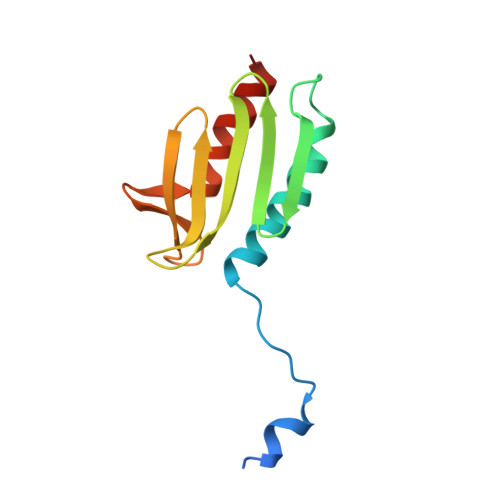The molecular basis of iron-induced oligomerization of frataxin and the role of the ferroxidation reaction in oligomerization.
Soderberg, C.A., Rajan, S., Shkumatov, A.V., Gakh, O., Schaefer, S., Ahlgren, E.C., Svergun, D.I., Isaya, G., Al-Karadaghi, S.(2013) J Biol Chem 288: 8156-8167
- PubMed: 23344952
- DOI: https://doi.org/10.1074/jbc.M112.442285
- Primary Citation of Related Structures:
4EC2 - PubMed Abstract:
The role of the mitochondrial protein frataxin in iron storage and detoxification, iron delivery to iron-sulfur cluster biosynthesis, heme biosynthesis, and aconitase repair has been extensively studied during the last decade. However, still no general consensus exists on the details of the mechanism of frataxin function and oligomerization. Here, using small-angle x-ray scattering and x-ray crystallography, we describe the solution structure of the oligomers formed during the iron-dependent assembly of yeast (Yfh1) and Escherichia coli (CyaY) frataxin. At an iron-to-protein ratio of 2, the initially monomeric Yfh1 is converted to a trimeric form in solution. The trimer in turn serves as the assembly unit for higher order oligomers induced at higher iron-to-protein ratios. The x-ray crystallographic structure obtained from iron-soaked crystals demonstrates that iron binds at the trimer-trimer interaction sites, presumably contributing to oligomer stabilization. For the ferroxidation-deficient D79A/D82A variant of Yfh1, iron-dependent oligomerization may still take place, although >50% of the protein is found in the monomeric state at the highest iron-to-protein ratio used. This demonstrates that the ferroxidation reaction controls frataxin assembly and presumably the iron chaperone function of frataxin and its interactions with target proteins. For E. coli CyaY, the assembly unit of higher order oligomers is a tetramer, which could be an effect of the much shorter N-terminal region of this protein. The results show that understanding of the mechanistic features of frataxin function requires detailed knowledge of the interplay between the ferroxidation reaction, iron-induced oligomerization, and the structure of oligomers formed during assembly.
Organizational Affiliation:
Center for Molecular Protein Science, Institute for Chemistry and Chemical Engineering, Lund University, P. O. Box 124, SE-221 00 Lund, Sweden.















